Cicada killers or ground hornets are wasps that make their homes in the ground. These wasps have the scientific name Sphecius speciosus.
Their primary benefit is that they maintain control over the cicada population. Because of this, they live near the trees where cicadas feed.
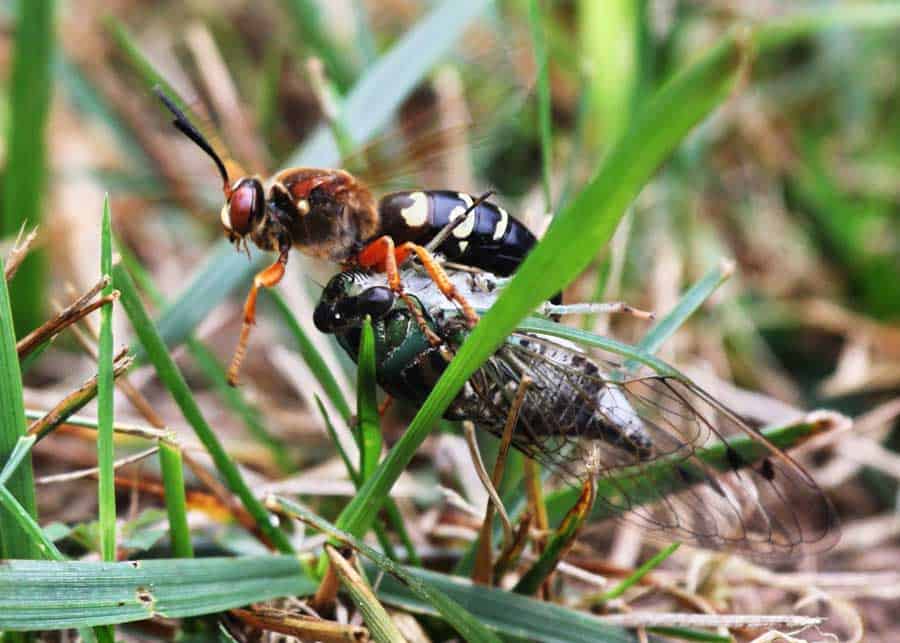
Table of Contents
Guide to Ground Hornets
In this guide, you’ll learn all about ground hornets. This includes their diet, range, nesting habits, size, and many other facts. Plus lots of photos, including with cicadas – their favorite meal.
What Ground Hornets Look Like
Ground hornets measure between 0.6 and 2.0 inches long. They resemble hairy hornets and yellowjackets with light yellow stripes on their rear segments.
Most of their abdominal segments are black or reddish-brown. They have brown wings, and the females are larger than the males of the species.
As their primary prey are cicadas, the cicada killer wasp is the largest wasp species in the Eastern United States.
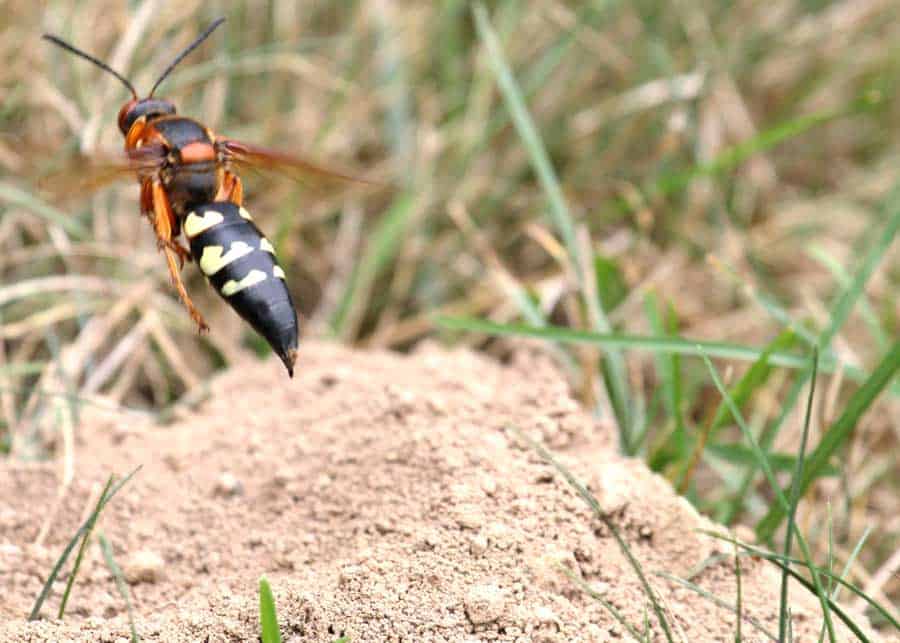
Ground Hornet Common Names
People refer to ground hornets by several names:
- Cicada killer
- Cicada hawk
- Digger wasps
- Sand hornets
- Eastern cicada killer wasp
- Ground hornets
The scientific name of ground hornets is Sphecius speciosus.
Where Do Ground Hornets Live?
Cicada killers live in the Eastern and Midwest areas of North America. They also live in Mexico and South America. Basically, they live anywhere that cicadas live.
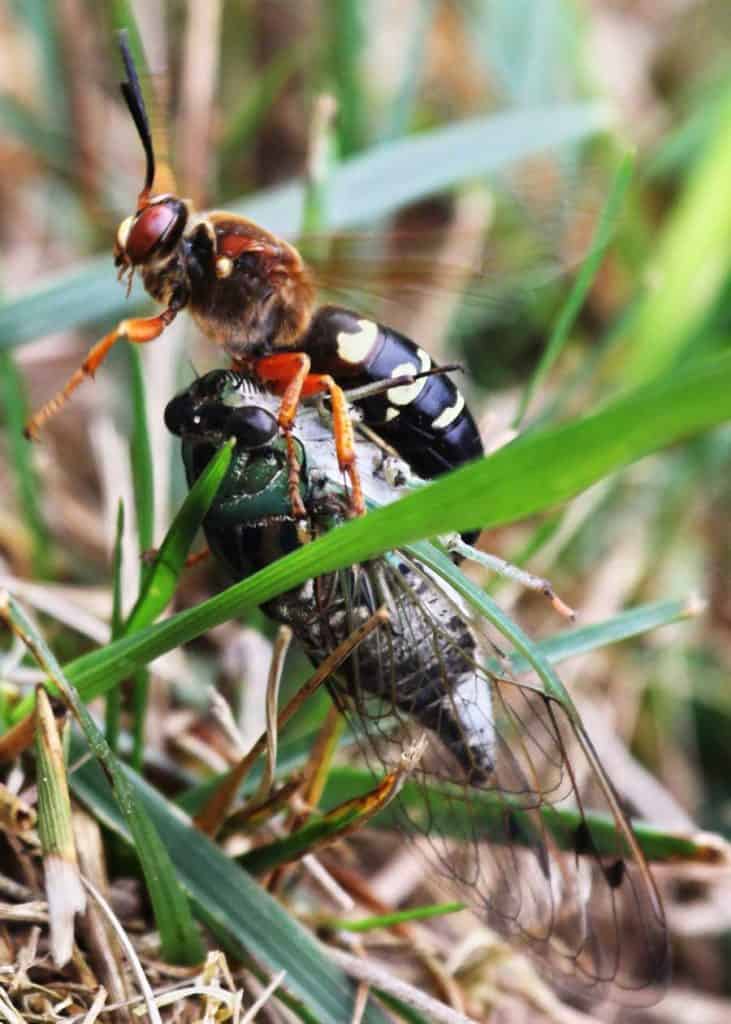
What Are Ground Hornet Nesting Habits?
Cicada killer wasps do not live in a social, communal nest.
They are solitary, although they will nest near other cicada wasps, as they tend to nest near deciduous trees, retaining walls, sandy areas, and southeast-facing slopes.
They also live in lawns, along the edges of driveways and sidewalks, in the sandy areas around playgrounds, and golf course sand traps.
The male wasps arrive in nesting areas before the females do. They fly around people, pets, or other creatures near the nest.
The males cannot sting. After the females arrive a week or two later, they mate and dig their nest, which can be up to 40 inches deep with several chambers.
While digging, female cicada killers can remove up to a half-gallon of soil.
Most females will make four nests. The excavated soil creates a U-shaped mound at the entrance, making them easy to spot.
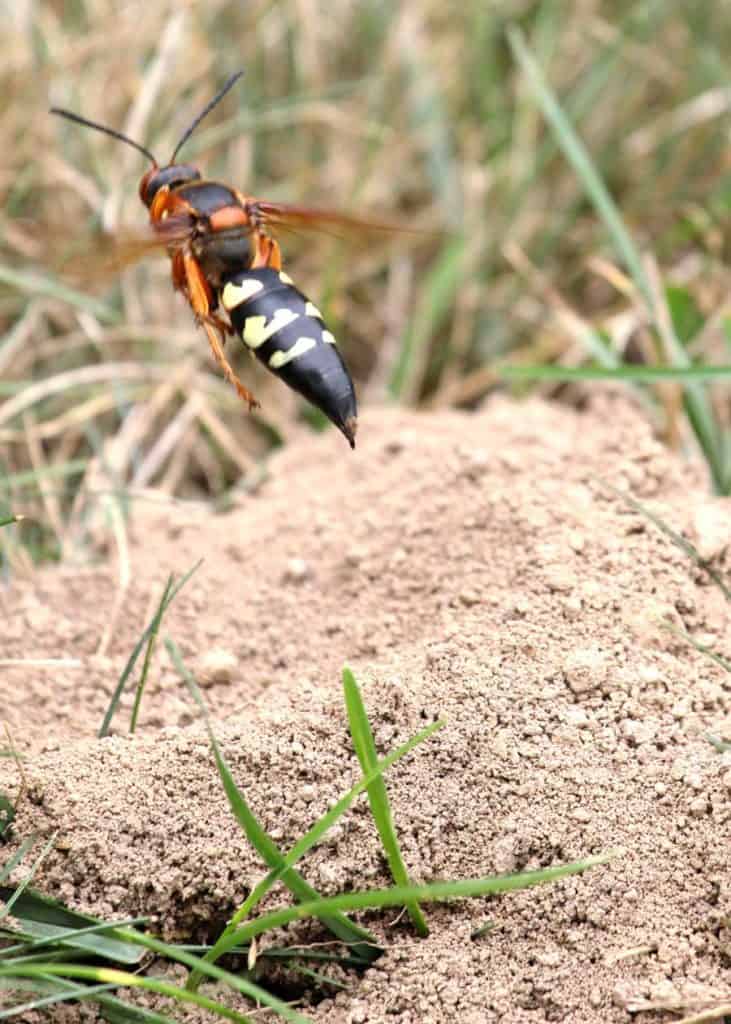
What Do Ground Hornets Eat?
Ground hornets eat cicadas, flower nectar, fermented tree sap, and large plants. They build their nests near their food sources.
And while hornets don’t make honey, they love to eat it.
How Long Do Ground Hornets Live?
Ground hornets live for a generation. Outside of the nest, they live about 75 days – from late June to mid-September. The males die after mating. And then the females die after providing food for the eggs they lay.
Ground hornets begin life as grub-like larva. They live in the protective chambers of the female wasp’s burrow.
After resting in stasis through the winter, ground hornets change into pupa in the spring and then emerge from the nest as an adult in the summer.
In the adult stage, they feed, mate, and dig a burrow to continue the cycle. During the egg-laying stage, they hunt for cicadas and bring them back to their nest to feed eggs.
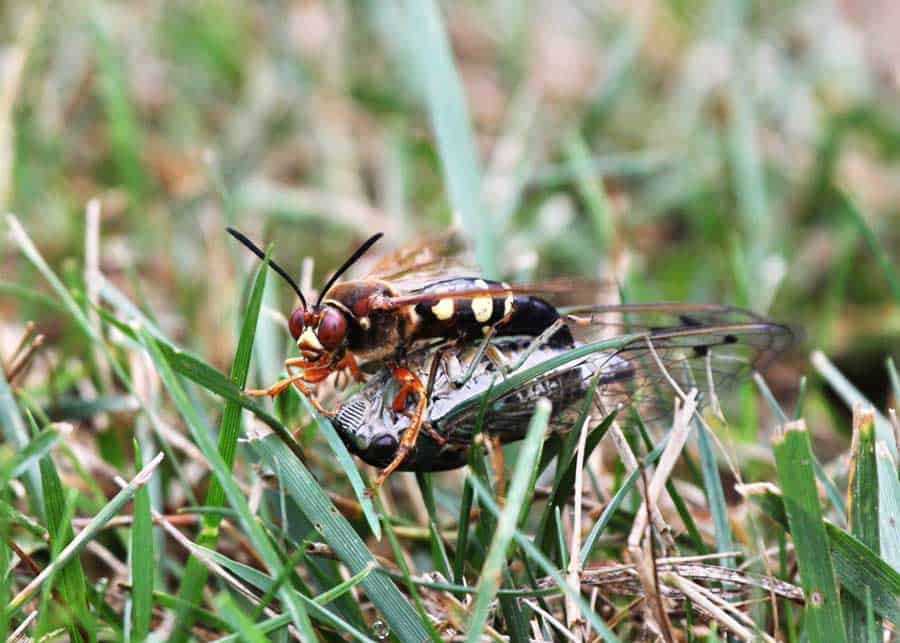
Benefits of Cicada Killer Wasps
Cicada killer wasps might look intimidating, but they are beneficial.
One female can kill up to 100 cicadas. The wasps sting the cicada, then bring it back to the nest. The male wasps each get one cicada, while the females get two or three. The wasp lays an egg and puts a cicada or two in the chambers in the nest.
After 24 to 48 hours, the eggs hatch and the larvae eat the cicada for about four days.
Once the larva eats the cicada, it spins a cocoon and remains in a diapause state until the next spring when it pupates. The brown cocoon has pores around the middle and measures about 1.25 inches.
Dangers of Ground Hornets
Ground hornets are not dangerous unless they need to defend themselves. As the males protect the burrow until the females emerge, they will dive-bomb when provoked. Male ground hornets do not have stingers.
Female ground hornets can sting, but ground hornets are busy hunting for cicadas and not looking to sting unless provoked.
Generally, the species is not as aggressive as other wasps, like yellowjackets. Cicada killer wasps look frightening, which is why homeowners and business owners want to remove them from the exterior spaces.
When they sting, ground hornets release a mild venom, but it isn’t as painful as the venom from other wasps and hornets.
Cicada killer wasps can damage property from their tunneling. Their tunnels can be up to 40 inches deep this can weaken soil under retaining walls and concrete slabs.
Since the wasps dig solitary tunnels, having several wasps in one area can cause significant damage if ignored. The excavated soil can damage grass or other plants because it prevents them from getting sunlight.
Tips to Control Ground Hornets
Cicada killers might look intimidating, but they are helpful. They manage the cicada population, and these big, noisy insects can damage young trees. Cicadas aren’t dangerous to humans, animals, or most plants, but they aren’t helpful either.
Homeowners and business owners have a few methods to control ground hornets. Prevention is the best method for removing them, as they have a short life span and only emerge from their nests for a few weeks in the summer. The insects burrow in similar spaces, so preventative methods work well. Females dig new burrows each summer.
Preventative Measures
If you have bare spots on your lawn, thicken them by overseeding. Then, discourage nesting activity by sprinkling water where the cicada killers have previously burrowed. They do not like moisture near their nests.
If they burrow in ornamental beds, cover the bed with up to three inches of mulch or a thick groundcover. You can also cover the beds with landscape fabric so the wasps cannot dig new burrows.
How to Control Cicada Killers with Insecticides
After attempting preventative methods, the next steps include chemicals and insecticides. You can put an insecticide at the entrance of the burrow. Choose an insecticide made for ground-nesting wasps and bees.
The best time to apply the insecticide is immediately after the wasp digs the nest. If you wait too long, the female dies, and she never brings the insecticide into the nest.
Unfortunately, since cicada killers only nest for the short term, insecticide use is more challenging.
More Reading: Bee vs Wasp vs Hornet: 15 Ways to Identify (Differences Compared)
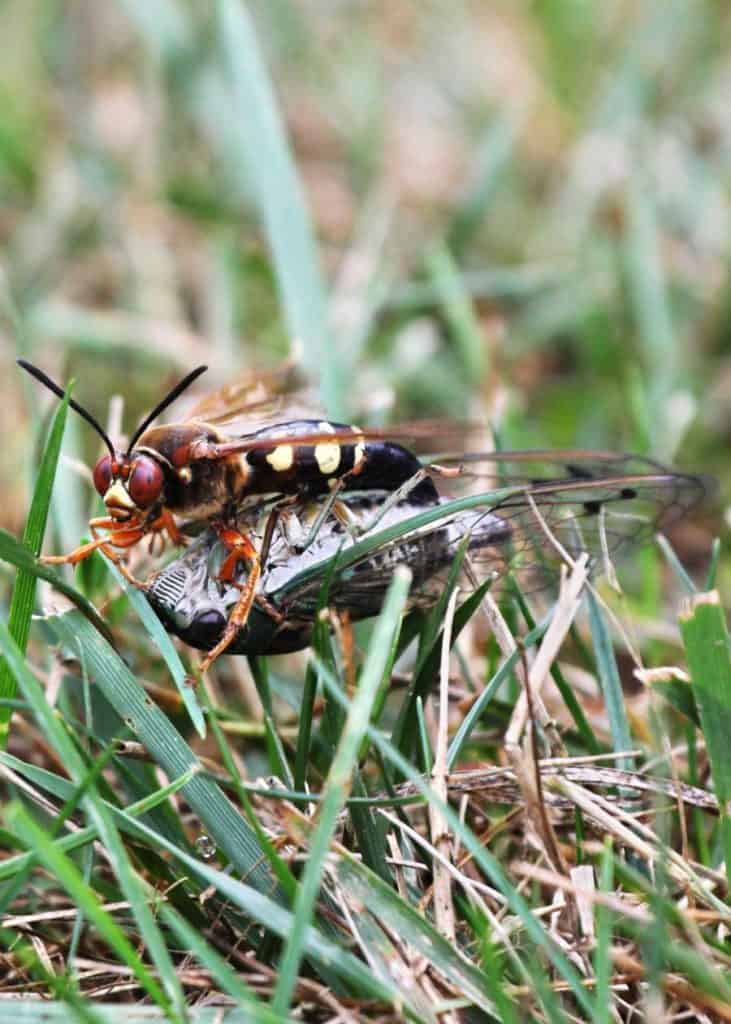
Want to keep wasps away? Here are 17 essential oils that repel wasps.
Common Questions About Ground Hornets
Here are answers to common questions about ground hornets.
Are cicada killers hornets?
You might be surprised to learn that ground hornets aren’t actually hornets. They are actually a type of wasp.
The best way to tell the difference between hornets and wasps is by colony size. A wasp colony tends to be smaller with fewer than 100 individuals. Hornet colonies are much larger. It’s quite difficult to tell the difference between the insects by appearance.
Truly Nolen
Does their sting hurt?
Yes, but not as much as a sting from an aggressive hornet. Since cicada killers occasionally nest in sandboxes, they may sting children who play near their nests.
Are cicada killers the same as murder hornets?
No. Murder hornets are called giant Asian hornets. They are an invasive species from South and East Asia that destroys complete colonies of honey bees and paper wasps.
They attack nests, then chew their way through the hive. They will sting humans, and the venom creates a painful sensation.
Will ground hornets make nests in human homes?
No. They burrow near homes, but they don’t nest inside houses or other buildings.
They want to be near the deciduous trees and flowering shrubs where cicadas live. If they burrow near a window or door, there is a chance they could enter your home. But, they won’t want to stay there.
Learn more about how to identify the types of wasp nests.
Your Turn
Have you seen ground hornets before? Have a question or maybe an experience to share? Join me in the comments.
- About the Author
- Latest Posts
Bryan Haines is a co-founder and writer at The Buginator. And is working to make it the best resource for taking back the outdoors from biting, stinging pests.
He also blogs about travel at Storyteller.Travel and photography at Storyteller Tech. Bryan is a partner at Storyteller Media, a publishing company he runs with his wife, Dena.
